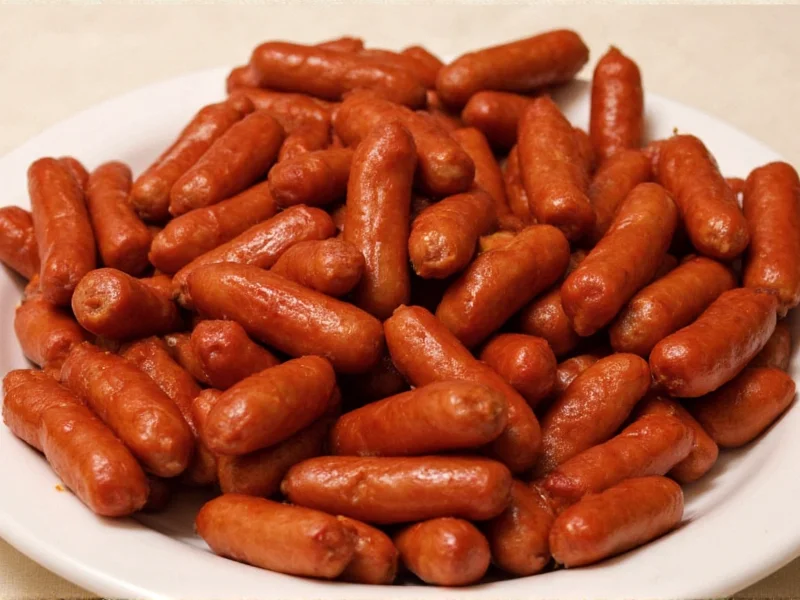Yes, traditional andouille sausage is typically spicy due to its signature blend of cayenne pepper and black pepper, though commercial versions can range from mildly spicy to quite hot depending on the recipe and regional variations.
When you're reaching for that distinctive smoked sausage to add depth to your gumbo or jambalaya, understanding its heat level is crucial for recipe success. Andouille sausage, with its rich history rooted in both French and Cajun culinary traditions, brings more than just meaty flavor to the table—it delivers a characteristic kick that defines many Southern dishes.
What Exactly Is Andouille Sausage?
Originating in France but perfected in Louisiana, authentic andouille is a coarse-grained, heavily smoked sausage traditionally made from pork shoulder and tripe. The Cajun adaptation transformed it into the robustly flavored ingredient we recognize today—a far cry from its milder French predecessor. This evolution introduced the signature spice profile that makes andouille stand out among smoked sausages.
The Spice Profile: What Makes Andouille Sausage Spicy?
The heat in traditional Cajun andouille comes primarily from two sources:
- Cayenne pepper - The primary heat contributor, typically comprising 1-3% of the seasoning blend
- Freshly cracked black pepper - Adds both heat and complex peppery notes
Additional spices like paprika, garlic, and thyme complement rather than diminish the heat. Unlike some sausages that rely on chili flakes for heat, authentic andouille uses ground cayenne pepper for a more consistent, penetrating warmth throughout the meat.
| Spice Component | Heat Contribution | Typical Amount |
|---|---|---|
| Cayenne pepper | Medium to high (30,000-50,000 SHU) | 1-3% of seasoning mix |
| Black pepper | Low to medium (5,000-10,000 SHU) | 2-4% of seasoning mix |
| Paprika | Mild (500-1,000 SHU) | 1-2% of seasoning mix |
How Spicy Is Andouille Sausage Compared to Other Sausages?
Understanding andouille's heat level requires context. Here's how it compares to other popular sausages:
- Andouille vs. Kielbasa - Traditional Polish kielbasa contains little to no heat, while andouille delivers noticeable warmth from cayenne
- Andouille vs. Chorizo - Mexican chorizo tends to be spicier with fresh chilies, while Spanish chorizo focuses more on paprika; andouille sits between them in heat level
- Andouille vs. Italian Sausage - Hot Italian sausage uses red pepper flakes for heat, but andouille's cayenne creates a different, more pervasive warmth
On the Scoville scale, a typical andouille sausage registers between 500-2,500 units—comparable to a mild to medium jalapeño pepper. This places it firmly in the "noticeably spicy but not overwhelming" category for most palates.
Regional and Commercial Variations in Spiciness
Not all andouille sausages deliver the same heat level. Several factors influence spiciness:
Traditional Cajun Andouille
Handmade versions from Louisiana butchers often feature pronounced heat, with cayenne comprising up to 3% of the seasoning blend. These artisanal sausages represent the authentic spicy profile that defines classic Cajun cooking.
Commercial Andouille Products
Mass-produced versions vary significantly:
- National brands often reduce cayenne content to appeal to broader markets
- "Mild" labeled products may contain no cayenne at all
- Some "andouille-style" sausages are merely smoked with minimal spice
When purchasing, check labels for cayenne pepper in the ingredients list—its presence and position indicate heat level. Products listing cayenne among the first five ingredients will be noticeably spicier than those where it appears near the end.
Cooking Considerations: How Heat Behaves in Dishes
Understanding how andouille's spiciness interacts with other ingredients is essential for balanced cooking:
- The fat content helps distribute heat evenly throughout dishes
- Smoking process intensifies pepper flavors while mellowing raw heat
- Longer cooking times allow spice to permeate the entire dish
- Acidic ingredients like tomatoes can heighten perceived heat
When using andouille in recipes like gumbo or red beans and rice, remember that its spice contributes to the dish's overall heat profile. If sensitive to spice, consider partially cooking the sausage separately and adding it later to control heat levels.
Milder Alternatives for Those Sensitive to Spice
If traditional andouille's heat proves too intense, several alternatives maintain flavor while reducing burn:
- Seek products specifically labeled "mild andouille"
- Use smoked turkey sausage with added paprika for color
- Substitute with kielbasa and add 1/4 teaspoon cayenne per pound
- Create your own mild version using sweet paprika instead of cayenne
Many Louisiana-based producers now offer "mild" versions that maintain the distinctive smoky flavor while significantly reducing the cayenne content. These provide the authentic texture and smoke without the pronounced heat.
Authenticity vs. Accessibility in Modern Andouille
The evolution of andouille sausage reflects broader food trends—traditional recipes meet modern palates. While authentic Cajun butchers maintain the spicy profile that defines the sausage, commercial producers often adjust heat levels for wider appeal. This creates a spectrum of products under the "andouille" name, from authentically spicy to barely warm.
For the most accurate representation of traditional andouille's spice profile, seek products from Louisiana-based producers who emphasize their Cajun heritage. These typically honor the original balance of smoke and heat that makes andouille indispensable in authentic Southern cooking.











 浙公网安备
33010002000092号
浙公网安备
33010002000092号 浙B2-20120091-4
浙B2-20120091-4